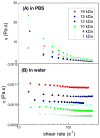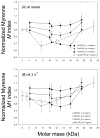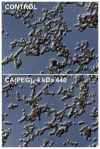Effects of amphiphilic star-shaped poly(ethylene glycol) polymers with a cholic acid core on human red blood cell aggregation
- PMID: 23262308
- PMCID: PMC3563249
- DOI: 10.1016/j.jmbbm.2012.11.008
Effects of amphiphilic star-shaped poly(ethylene glycol) polymers with a cholic acid core on human red blood cell aggregation
Abstract
Elevated red blood cell (RBC) aggregation increases low-shear blood viscosity and is closely related to several pathophysiological diseases such as atherosclerosis, thrombosis, diabetes, hypertension, cancer, and hereditary chronic hemolytic conditions. Non-ionic linear polymers such as poly(ethylene glycol) (PEG) and Pluronic F68 have shown inhibitory effects against RBC aggregation. However, hypersensitivity reactions in some individuals, attributed to a diblock component of Pluronic F68, have been reported. Therefore, we investigated the use of an amphiphilic star-shaped PEG polymer based on a cholic acid core as a substitute for Pluronics to reduce RBC aggregation. Cholic acid is a natural bile acid produced in the human liver and therefore should assure biocompatibility. Cholic acid based PEG polymers, termed CA(PEG)(4), were synthesized by anionic polymerization. Size exclusion chromatography indicated narrow mass distributions and hydrodynamic radii less than 2 nm were calculated. The effects of CA(PEG)(4) on human RBC aggregation and blood viscosity were investigated and compared to linear PEGs by light transmission aggregometry. Results showed optimal reduction of RBC aggregation for molar masses between 10 and 16 kDa of star-shaped CA(PEG)(4) polymers. Cholic acid based PEG polymers affect the rheology of erythrocytes and may find applications as alternatives to linear PEG or Pluronics to improve blood fluidity.
Copyright © 2012 Elsevier Ltd. All rights reserved.
Figures







Similar articles
-
Asymmetric poly(ethylene glycol) star polymers with a cholic acid core and their aggregation properties.Biomacromolecules. 2009 Apr 13;10(4):900-6. doi: 10.1021/bm801423p. Biomacromolecules. 2009. PMID: 19281151
-
Aggregation of human RBC in binary dextran-PEG polymer mixtures.Biorheology. 2001;38(1):53-68. Biorheology. 2001. PMID: 11381165
-
Aggregation and thermoresponsive properties of new star block copolymers with a cholic acid core.Langmuir. 2011 Sep 6;27(17):11174-9. doi: 10.1021/la2021929. Epub 2011 Aug 12. Langmuir. 2011. PMID: 21800871
-
Lipid-polymer hybrid nanoparticles as a new generation therapeutic delivery platform: a review.Eur J Pharm Biopharm. 2013 Nov;85(3 Pt A):427-43. doi: 10.1016/j.ejpb.2013.07.002. Epub 2013 Jul 17. Eur J Pharm Biopharm. 2013. PMID: 23872180 Review.
-
Application of star poly(ethylene glycol) derivatives in drug delivery and controlled release.J Control Release. 2020 Jul 10;323:565-577. doi: 10.1016/j.jconrel.2020.04.039. Epub 2020 Apr 25. J Control Release. 2020. PMID: 32343992 Review.
Cited by
-
Erythrocyte rheological properties but not whole blood and plasma viscosity are associated with severity of hypertension in older people.Z Gerontol Geriatr. 2017 Apr;50(3):233-238. doi: 10.1007/s00391-016-1039-8. Epub 2016 Apr 26. Z Gerontol Geriatr. 2017. PMID: 27115524 English.
-
Bioinks for 3D bioprinting: an overview.Biomater Sci. 2018 May 1;6(5):915-946. doi: 10.1039/c7bm00765e. Biomater Sci. 2018. PMID: 29492503 Free PMC article. Review.
-
Paclitaxel-loaded star-shaped copolymer nanoparticles for enhanced malignant melanoma chemotherapy against multidrug resistance.Drug Des Devel Ther. 2017 Mar 6;11:659-668. doi: 10.2147/DDDT.S127328. eCollection 2017. Drug Des Devel Ther. 2017. PMID: 28293102 Free PMC article.
-
The Effect of Covalently-Attached ATRP-Synthesized Polymers on Membrane Stability and Cytoprotection in Human Erythrocytes.PLoS One. 2016 Jun 22;11(6):e0157641. doi: 10.1371/journal.pone.0157641. eCollection 2016. PLoS One. 2016. PMID: 27331401 Free PMC article.
-
Delivery of drugs bound to erythrocytes: new avenues for an old intravascular carrier.Ther Deliv. 2015 Jul;6(7):795-826. doi: 10.4155/tde.15.34. Ther Deliv. 2015. PMID: 26228773 Free PMC article. Review.
References
-
- Rad S, Neu B. Impact of cellular properties on red cell-red cell affinity in plasma-like suspensions. European Physical Journal E. 2009;30(2):135–40. - PubMed
-
- MacRury S, Lennie S, McColl P, Balendra R, MacCuish A, Lowe G. Increased red cell aggregation in diabetes mellitus: Association with cardiovascular risk factors. Diabet Med. 1993;10(1):21–26. - PubMed
-
- Ziegler O, Guerci B, Muller S, Candiloros H, Méjean L, Donner M, et al. Increased erythrocyte aggregation in insulin-dependent diabetes mellitus and its relationship to plasma factors: A multivariate analysis. Metabolism. 1994;43(9):1182–86. - PubMed
-
- Shiga T, Maeda N, Kon K. Erythrocyte rheology. Crit Rev Oncol Hematol. 1990;10:9–48. - PubMed
-
- Somer T, Meiselman H. Disorders of blood viscosity. Annals of Medicine. 1993;25:31–39. - PubMed
Publication types
MeSH terms
Substances
Grants and funding
LinkOut - more resources
Full Text Sources
Other Literature Sources

